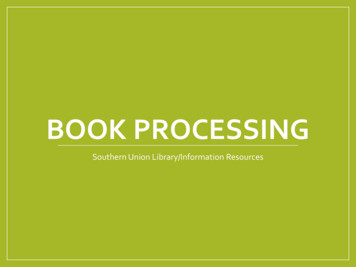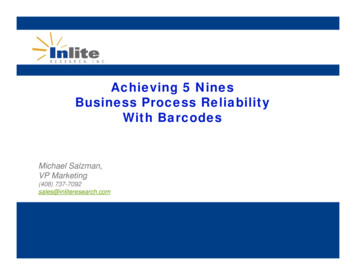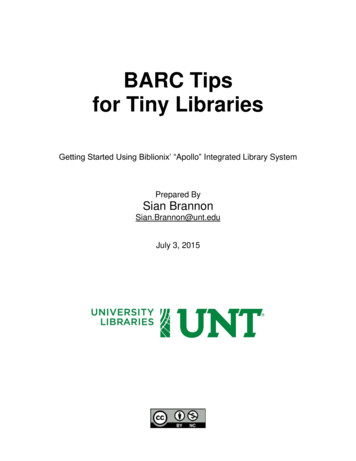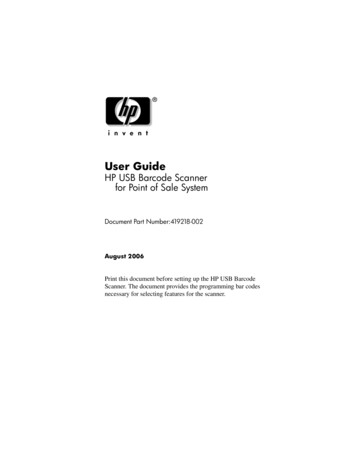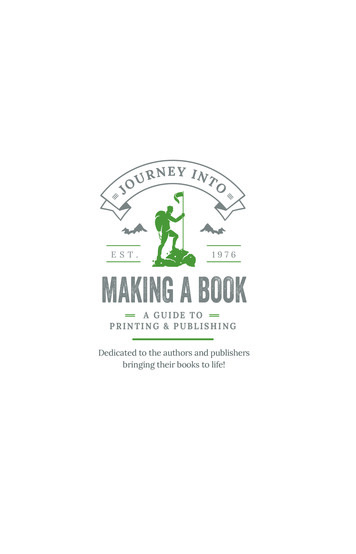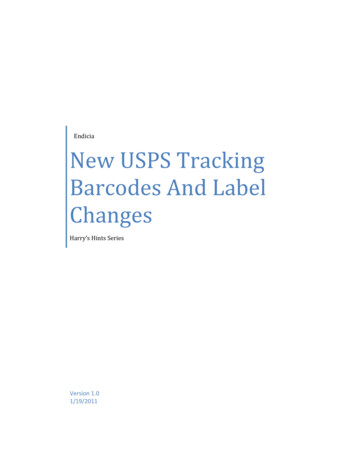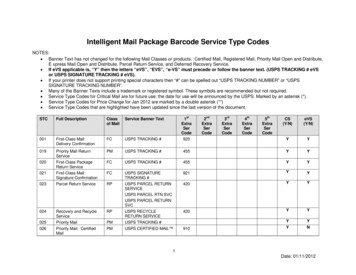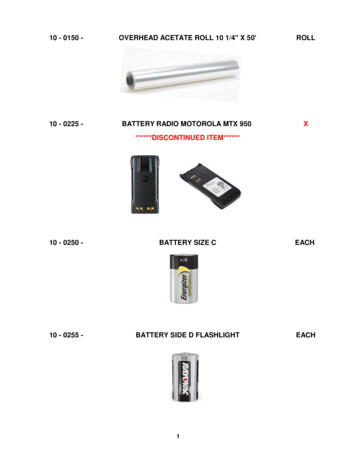
Transcription
2D Barcode FontsQR Code de.shtmlCopyright (c) 2009-2021, ConnectCodeAll Rights Reserved.ConnectCode accepts no responsibility for any adverse affect that may result from undertaking ourtraining.Microsoft and Microsoft Excel are registered trademarks of Microsoft Corporation. All other productnames are trademarks, registered trademarks, or service marks of their respective owners
Table of Contents1.2.3.4.5.6.7.8.9.10.11.QR Code Barcode . 1-21.1QR Code Barcode . 1-21.2ConnectCode QR Code Barcode Font . 1-21.2.1 Data Compaction . 1-21.3Parameters of the QR Code Barcode . 1-31.3.1 Error Correction. 1-31.3.2 Mask . 1-31.4QR Code Barcode Fonts . 1-3Font Encoder . 2-4.NET SDK . 3-53.1.NET Framework 4.0 Notes . 3-6.NET Standard SDK . 4-7Windows UI (WinUI) . 5-8Blazor . 6-14JavaScript SDK . 7-187.1QR Code Barcode with JavaScript and Barcode Web Fonts . 7-18Component Object Model Library . 8-198.1Tutorial on creating QR Code using COM . 8-20PowerBuilder . 9-249.1Tutorial on creating a QR Code in PowerBuilder . 9-24Crystal Reports UFL . 10-2910.1Tutorial on creating QR Code with Crystal Reports UFL . 10-29Microsoft Reporting Services . 11-3511.1Configuring Visual Studio . 11-3511.2Configuring Reporting Services . 11-3711.3Create barcodes in a Microsoft Reporting Services (SSDT) . 11-38Pg 1-1QR Code Barcode
1.1.1QR Code BarcodeQR Code BarcodeThe QR Code (Quick Response) barcode is a 2-dimensional barcode consisting of black squarepatterns on a white background. The barcode is capable of storing more information than aconventional barcode. It is developed by Denso-Wave in Japan and is one of the more popular 2dimensional barcodes. Another reason for this barcode popularity is because it is adopted by manymobile or smartphone applications for linking physical world objects to a web URL (UniformResource Locator).1.2ConnectCode QR Code Barcode FontThis is a professional True Type (TTF) barcode font that is used to create a QR Code barcode byselecting a font in your favourite text editor. The package includes a standalone encoder, a .NetDynamic Link Library (DLL), true type font for creating a QR Code barcode that strictly adheres toindustry specifications.1.2.1Data CompactionThe QR Code is able to pack large amount of data using the various compaction methods. Each ofthe compaction method is optimized for a specific type of data. For example, the Numeric methodis optimized for numbers. The ConnectCode encoder automatically scans through the data anddetects the most optimized compaction method. On top of that, it also switches among thedifferent compaction methods if one method is unable to fully encode the data. Numeric - Optimized for numbers.Alphanumeric - Optimized for numbers and alphabets. This compaction method is lessoptimized than Numeric.Binary - Optimized for any 8-bit binary data.Kanji - Optimized for Kanji data.Pg 1-2QR Code Barcode
1.3Parameters of the QR Code BarcodeThe following sections detail the different configurable parameters of the QR Code barcode. If youare new to this barcode, it is recommended that you use the default or automatic settingsmentioned below.1.3.1Error CorrectionQR Code uses the Reed-Solomon error correction technique. This allows the barcode to be partiallydamaged without causing any loss of data. There are four different levels of error correction thatcan be chosen. The higher the level, the more resilient the barcode is to withstand damage.However the drawback is that more data codewords in the barcode are needed to store the errorcorrection codewords instead of the actual data. LevelLevelLevelLevel1.3.2L MQH-7% of codewords can be recovered15% of codewords can be recovered25% of codewords can be recovered30% of codewords can be recoveredMaskQR Code's reliability can be improved by a method called masking. Masking regularizes thedistribution of the black square patterns. Different types of masking patterns according to thespecifications are supported by the ConnectCode QR Code. The default automatic masking optionis recommended if you do not want to delve into the technical implementation of the barcode. Mask 0 – Mask Pattern 0Mask 1 – Mask Pattern 1Mask 2 – Mask Pattern 2Mask 3 – Mask Pattern 3Mask 4 – Mask Pattern 4Mask 5 – Mask Pattern 5Mask 6 – Mask Pattern 6Mask 7 – Mask Pattern 7Auto – Automatic Masking1.4QR Code Barcode FontsThe following is the description of the QR Code barcode font used by the encoder or .Net DLL.Font NameDescriptionRecommended SizesCCodeQRStandard QR Code Barcode Font.Font Size 2.64(CCodeQR Trial for theTrial version)Note1. You may see spaces between multiple Rows when you use the QR Code barcode fonts incertain font sizes. The spaces can be easily removed by increasing or decreasing the fontsize by 1 point.Pg 1-3QR Code Barcode
2.Font EncoderThe QR Code Barcode Font package in ConnectCode comes bundled with a Font Encoder thatallows you to encode the barcode quickly and easily. This is useful if you like to encode a singlebarcode to be pasted into your brochure, on packaging or product items. The Encoder supports allparameters as described in the sections above.The Error Level and Mask are parameters that are supported (see previous section for detaileddescription).The Font Name and Font Size in the “Output” section can be changed after the QR Code barcode iscreated. This allows the height and the size of the barcode to be changed after the barcode iscreated.The “Show As Text” option allows you to see the text output of the barcode in a normal text font.The “Copy Barcode” button allows the barcode to be copied and pasted onto other applicationseasily.Pg 2-4QR Code Barcode
3.NET SDKA .NET Barcode SDK is also bundled in the ConnectCode QR Code Barcode Font package. This SDKcan be bundled in your applications if you purchase the necessary distribution licenses.Library lass NameQRCodeRequirements.NET 2.0 and onwardsConstructors and FunctionsQR(String data, String errorcorrectionlevel, int mask);This is the constructor for the QR barcode. It is used for initializing the QR barcode.data : The data input string to be encoded as a barcode.errorcorrectionlevel : The Error Correction Level “L”, “M”, “Q” or “H”.mask : Mask Pattern. Any number from 0.7 or 8 for Auto.String Encode();This function encodes the barcode based on the parameters specified in the constructor. The resultwill be returned as a string.int LengthExceeded();The Encode() function may return an empty output string either due to invalid inputs or the lengthof the data exceeded the length specified by the QR Code specifications. A call to this functionafter the Encode() function allows you to determine whether the data length has exceeded.Pg 3-5QR Code Barcode
Sample Usage (C#)Using ConnectCode.BarcodeFonts2D;.QR barcode new QR("12345678",”M”,0);String result barcode.Encode();Font font new Font("CCodeQR", 8);richTextBox1.Text outputstr; //private System.Windows.Forms.RichTextBox .SelectionFont font;Sample Visual Studio Project Name - ConnectCode Encoder Solution Name - ConnectCode.sln Language - C# Requirements - .NET 2.0 and onwards, Visual Studio 2008, 2010, 2012, 2013, 2017 andonwards.3.1.NET Framework 4.0 Notes.NET Framework 4.0 includes and uses CLR 4.0. It does not automatically use its version of thecommon language runtime to run applications that are built with earlier versions of .NETFramework. This is unlike .NET 2.0-3.5 where the framework uses CLR 2.0 to run applications.Basically, there is no version 3 of the CLR.Hence, ConnectCode 2D Barcode SDK provides two sets of .NET DLLs for different versions of the.Net Framework as shown below:For .NET 2.0 to 3.5 please use the DLLs and samples in /Resource subdirectory/.Net Samples subdirectoryFor .NET 4.0 please use the DLLs and samples in /Net4 subdirectory/Net4/.Net Samples subdirectoryPg 3-6QR Code Barcode
4.NET Standard SDK.NET Framework is a software framework that is developed by Microsoft to run primarily onMicrosoft Windows. Over the years, the framework has been forked and enhanced to serve manydifferent purposes. For example, the Universal Windows Platform uses a specific set of APIs fromthe .NET Framework to help programmers develop apps for the Windows Store. The .NET CoreFramework also uses a subset of APIs from the .NET Framework to support the development ofapplications that can run on different operating systems such as Windows, Mac, and Linux.NET Standard is a specification of common APIs that are available on the different .NETframeworks. By creating a class library (DLL) that targets the .NET Standard, a developer can beassured that his library can be used or shared by projects developed on the various .NETframeworks.As of .NET Standard v2.0, the .Net Standard specification is implemented by the followingframeworks: .NET Core.NET FrameworkMonoXamarin.iOSXamarin.AndroidUniversal Windows Platform.NET Standard QR Code Library ode.dllThe QR Code Barcode package includes a .NET Standard compliant QR Code class library (alsoavailable as a nuget) that targets the .NET Standard 2.0 specification. This library can be used byprojects developed on different .NET frameworks and when used together with ConnectCodeBarcode Fonts, generates barcodes of the highest quality that is able to meet the strictestrequirements of the auto-id industry.Sample ASP.NET Core Sample Resource/NETStandard/ASPNETCoreQRCodeSamplePg 4-7QR Code Barcode
5.Windows UI (WinUI)In this tutorial, we are going to illustrate how to create a standards-compliant QR Code barcode ina WinUI (Windows UI Library) Desktop project. WinUI is a user experience framework that unitesWin32 and UWP developers to a common API for developing apps with modern user interfaces inWindows. The creation of a QR Code barcode involves the use of a .NET Standard 2.0 class libraryfor encoding input data and a Microsoft WinUI Canvas for displaying barcode. The class libraryensures the the QR Code compliance with the ISO/IEC 18004:2015 standards by validating inputdata, generating Error Correction Codewords, and applying necessary QR Code mask patterns.The class library returns a text string in the format of ones (1 - Black) and zeros (0 - White). Thisstring provides the flexibility of rendering QR Code in components such as a WinUI Canvas(reference code in this tutorial), other .NET Canvas, or System.Drawings. The QR Code can also bedisplayed by placing the text string into a WinUI TextBlock, TextBox, or RichTextBlock, and thenapplying a QR Code font (part of ConnectCode QR Code package). Finally, many modern documentformats such as Microsoft Word and Adobe PDF support font embedding. This means a Line ofBusiness (LOB) app can generate a document that includes a high-quality QR Code barcode by justusing a text string and a QR Code font embedded into the document.Prerequisite ConnectCode QR Code package is installedVisual Studio 2019 16.9 (or onwards)WinUI 3.0 (Project Reunion 0.5 or onwards)1. Launch Visual Studio and create a new project. Select the "Blank App, Packaged (WinUI inDesktop)" C# template and click on the Next button.Pg 5-8QR Code Barcode
2. In Configure your new project dialog, enter "WinUIQRCodeApp" as Project name, leaveeverything else as default values, and click on the Create button. A Visual Studio solutioncontaining WinUIQRCodeApp and WinUIQRCodeApp (Package) is created.3. Next, we add the QR Code class library available in nuget.org to the project. In the SolutionExplorer, right-click on WinUIQRCodeApp and select Manage Nuget Packages. In the NugetPackage Manager shown below, click on Browse and search for "ConnectCode QR Code". Select"NETStandardQRCode" and click on Install to add the class library.Pg 5-9QR Code Barcode
4. Add the QR Code font into the WinUIQRCodeApp Visual Studio project by right-clicking onWinUIQRCodeApp project in Solution Explorer. Select Add - New Folder and name the folder as"Fonts". Next, right-click on "Fonts" folder, select Add - Existing Item and navigate to thefollowing folder:C:\Program Files (x86)\ConnectCodeQRCode(or C:\Program Files (x86)\ConnectCodeQRCodeTrial if you are using the Trial version)Select the QR Code font:CCodeQR.ttf (or CCodeQR Trial.ttf)5. We have added a QR Code class library and a QR Code font to the project. As described in theoverview, we are going to generate a QR Code using the library and then display it on a WinUICanvas or with a barcode font. Click on MainPage.xaml in Solution Explorer and change the XAMLto the following: Windowx:Class "WinUIQRCodeApp.MainWindow"xmlns entation"xmlns:x s:local "using:WinUIQRCodeApp"xmlns:d 8"xmlns:mc ility/2006"mc:Ignorable "d" StackPanel Orientation "Vertical" HorizontalAlignment "Center" VerticalAlignment "Center" Button x:Name "myButton" Click "myButton Click" Click Me TextBlock x:Name "QRCodeBarcode"Margin "10" Canvas x:Name "QRCodeCanvas" Margin "10" /StackPanel /Window The TextBlock is used to display the text string returned by the class library. We will apply the fontto this text string later in the tutorial.Pg 5-10QR Code Barcode
6. Next, we add the C# code to encode the input data. Click on MainWindow.xaml.cs and add thefollowing to the top of the file.using Net.ConnectCode.BarcodeFontsStandard2D;Locate myButton Click function and add the following to the function.myButton.Content "Clicked";QR qr new QR("12345678","L",8);//ECL L-7% M-15% Q-25% H-30%//Mask 0.7 or 8 for Auto//There are 8 masks patterns to apply to a QR Code//The purpose is to make the QR Code easier to read for the scanners.string qrCodeStr qr.Encode();QRCodeBarcode.Text qrCodeStr;int squareD 10;double posX 0;double posY 0;foreach (char c in qrCodeStr){var rect new Microsoft.UI.Xaml.Shapes.Rectangle();rect.Width squareD;rect.Height squareD;Canvas.SetLeft(rect, posX);Canvas.SetTop(rect, posY);if (c '1'){rect.Fill new SolidColorBrush(Microsoft.UI.Colors.Black);posX posX squareD;}else if (c '0'){rect.Fill new SolidColorBrush(Microsoft.UI.Colors.White);posX posX squareD;}else if (c '\n'){posX 0;posY posY squareD;}QRCodeCanvas.Children.Add(rect);}The code above uses the Net.ConnectCode.BarcodeFontsStandard2D.QR class to generate a QRCode barcode text string using the input data "12345678", an ECL (Error Correction Level) of "L",and auto QR Code masks. A higher ECL setting generates a QR Code that can be recovered evenwhen it is partially damaged. However, this means more redundancy is added to the QR Code,resulting in a larger QR Code in size. If you are not sure of which ECL to use, we recommendstarting with "M" which provides a good balance between redundancy and size.Pg 5-11QR Code Barcode
7. Run the app in Visual Studio, click on "Click Me" button to see the generated QR Code.The first part after the button shows the text string of the QR Code class library. The second partshows the QR Code rendered on a WinUI Canvas.Pg 5-12QR Code Barcode
8. We can change the raw text string above into a QR Code by applying a QR Code font. Changethe code in MainWindow.xaml to the following: Windowx:Class "WinUIQRCodeApp.MainWindow"xmlns entation"xmlns:x s:local "using:WinUIQRCodeApp"xmlns:d 8"xmlns:mc ility/2006"mc:Ignorable "d" StackPanel Orientation "Vertical" HorizontalAlignment "Center" VerticalAlignment "Center" Button x:Name "myButton" Click "myButton Click" Click Me TextBlock x:Name "QRCodeBarcode"FontFamily "/Fonts/CCodeQR.ttf#CCodeQR"FontSize "10"Margin "10" Canvas x:Name "QRCodeCanvas" Margin "10" /StackPanel /Window If you are testing with the Trial version of the QR Code font, use the following:FontFamily "/Fonts/CCodeQR Trial.ttf#CCodeQR Trial"Run the application again and you should see the following:Pg 5-13QR Code Barcode
6.BlazorIn this tutorial, we illustrate how to create an ISO/IEC 18004:2015 compliant QR Code barcode ina Blazor WebAssembly app. Blazor is a framework developed by Microsoft for building interactiveweb apps using C#, .NET, and HTML. The framework supports apps hosted on ASP.NET CoreServer (Blazor Server), and Single-page apps (Blazor WebAssembly) that are downloaded ontoyour web browser before running. Both scenarios are supported by the method for QR Codegeneration described in this tutorial.The method involves the use of a .NET Standard 2.0 class library for encoding input data andapplying a barcode font to the result for display. This has the advantage of having nodependencies on any underlying graphics API. The class library validates input data, generatesError Correction Codewords, and applies necessary QR Code mask patterns before returning a textstring of ones (1 - Black) and zeros (0 - White). In this tutorial, we are using Visual Studio onWindows to demonstrate the QR Code generation process. It is possible to create QR Code usingthe same method with Visual Studio Code on other platforms.Prerequisite ConnectCode QR Code package is installedVisual Studio 2019 16.6 (or onwards)1. Launch Visual Studio and click on Create a new project. Select the "Blazor WebAssembly App"and click on Next button.2. In Configure your new project dialog, enter "BlazorQRCode" as Project name, leave everythingelse as default values, and click on the Next button. A Visual Studio solution containingWinUIQRCodeApp and WinUIQRCodeApp (Package) is created.In Additional Information dialog, choose .NET Core 3.1 (LTS) target framework and then theCreate button. You can also choose .NET 5 as the Target Framework if you like to.Pg 6-14QR Code Barcode
3. After the project is created, add the QR Code class library available in nuget.org to the project.In Solution Explorer, right-click on BlazorQRCode and select Manage Nuget Packages. In NugetPackage Manager shown below, click on Browse and search for "ConnectCode QR Code", select"NETStandardQRCode", and click on Install to add the class library (select version 1.0.2 or above).4. Next, add the QR Code font into the project. In Solutions Explorer, right-click on wwwroot,select Add - New Folder, and name the folder as "fonts". Next, right-click on "fonts" folder, selectAdd - Existing Item and navigate to the following folder:C:\Program Files (x86)\ConnectCodeQRCode\Resource\Fonts(or C:\Program Files (x86)\ConnectCodeQRCodeTrial\Resource\Fonts if you are using the Trialversion)Select the Web Open Format (WOFF) QR Code font:CCodeQR.woff (or CCodeQR Trial.woff)If your web project requires compatibility with older browsers that do not support WOFF, you canalso add the Open Type font in the same folder.Pg 6-15QR Code Barcode
5. In Solutions Explorer - Pages, click on Index.razor, and add the following code. div id "qrBarcodeFonts" @((MarkupString)qrCodeStr) /div @code {private string qrCodeStr "";protected override async Task OnInitializedAsync(){QR qr new QR("12345678", "M", 8);qr.NewLine " br / ";qrCodeStr qr.Encode();}}The razor code defines qrCodeStr with qrBarcodeFonts CSS style. qrCodeStr is initialized with theresult returned by the QR Code class library. For the code above, we are generating a QR Codewith "12345678" as the input, "M" (L, M, Q, and H) as the Error Correction Level, and "8" (Auto)as the Mask Pattern.If you are using the class library in a server or in a native application, the library will automaticallydetect the environment to return \n or \r\n using Microsoft Environment.NewLine. In our scenario,we are using the class library in a HTML environment, so we overwrite the NewLine character withthe HTML br tag.6. The last step is to apply QR Code barcode font to the text string result returned by the classlibrary. We have already specified qrBarcodeFonts style for the div element in the previous step,thus we just need to define this style in our CSS. In Solutions Explorer, click on css - app.css,and add the following CSS definitions into the file.@font-face {font-family: CCodeQR;src: url("./fonts/CCodeQR.woff") format("woff");}#qrBarcodeFonts {font-weight: normal;font-style: normal;line-height: normal;font-family: 'CCodeQR', sans-serif;font-size: 12px;letter-spacing: -1px;line-height: 98%;}Some browsers automatically add a very small space between characters vertically andhorizontally. This may result in the square patterns in the QR Code looking spaced out. This issuecan be removed by specifying the letter-spacing and line-height CSS property.Pg 6-16QR Code Barcode
7. In Visual Studio, click on IIS Express in the toolbar to run the application. You should see thefollowing Blazor WebAssembly application with a standards-compliant QR Code barcode.Pg 6-17QR Code Barcode
7.JavaScript SDKThis is an elegant solution that enables you to generate high quality QR Code barcodes usingJavaScript with a HTML5 Canvas or World Wide Web Consortium (W3C) compliant Web Fonts. Thegenerated QR Code barcode is able to meet the strictest industry requirements required by theauto-id industry.JavaScript QR Code Resource Folder Resource/JavascriptThe snippet below illustrates the use of the HTML5 Canvas tag on a HTML page. canvas id "barcodeCanvas" width 300 height 300 12345678 /canvas The following JavaScript code shows how to render a QR Code barcode on the HTML5 Canvas.var elementBarcode document.getElementById("barcodeCanvas");var barcode new QRCode(elementBarcode.innerHTML, "L", sInput Data: elementBarcode.innerHTML (or any other input string)Error Correction Level: "L" ("L", "M", "Q" or "H")L - Allows recovery of up to 7% data lossM - Allows recovery of up to 15% data lossQ - Allows recovery of up to 25% data lossH - Allows recovery of up to 30% data lossMask: 8 (0 to 7 or 8 for Auto)The purpose of a mask pattern is to make the QR code easier for QR scanner to read.7.1QR Code Barcode with JavaScript and Barcode Web FontsThe output generated by the JavaScript library can also be rendered as a QR Code Barcodethrough the use of a Web Open Font Format Font (WOFF). WOFF is an optimized font formatrecommended by World Wide Web Consortium (W3C) for use in web pages. It uses compressionon Open Type or True Type fonts to achieve file size reduction so that it can be efficientlydistributed over the web.The QR Code Barcode WOFF fonts provided by ConnectCode have been tested vigorously to displayand print on different desktop and mobile browsers. It is important to know that a font raster tothe output device and is not limited to DPI (Dots per Inch) of the computer screen. This enablesvery high quality QR Code barcodes to be generated.The font solution for generating barcodes is based on ConnectCode’s True Type barcode fontengine that has passed numerous independent audits and is widely adopted by many Fortune 500companies. QR Code fonts in Embedded Open Type (EOT), and Open Type (OTF) format are alsoprovided to ensure that the solution works on legacy browsers that have yet to fully supportWOFF.Pg 7-18QR Code Barcode
8.Component Object Model LibraryThis tutorial illustrates the use of a COM (Component Object Model) object library with a True TypeFont (QR Code Barcode Font), provided in ConnectCode QR Code package, to create a ISO/IEC18004:2015 standard-compliant QR Code in a .NET Windows Form application.Prerequisites ConnectCode QR Code package is installedQRCodeCOMLibrary.dll in the Resource\QRCodeCOMLibrary subdirectory of ConnectCodeQR Code package. The QR Code class library has been compiled with the "Register for COMinterop" Visual Studio project property, exposing a COM-callable wrapper that enablesCOM interaction.Visual Studio 2015/2017Administrator RightsPg 8-19QR Code Barcode
8.1Tutorial on creating QR Code using COM1. Launch the Visual Studio Developer Command Prompt as Administrator from the Windows StartMenu.2. In the Developer Command Prompt, use the "cd" command to go to the QR Code COM Libraryfolder.cd C:\Program Files or ConnectCodeQRCodeTrial if you are using the Trial package)3. Enter the following command in the Developer Command Prompt to use Regasm.exe to registerthe QRCode COMLibrary assembly for use with COM.Regasm QRCodeCOMLibrary.dll /tlb:QRCodeCOMLibrary.tlb /codebaseRegasm.exe adds information about the class to the system registry so that COM clients can usethe .NET Framework class transparently. The tlb option generates a type library defined within theassembly.4. Launch Visual Studio. Create a new Windows Form project by clicking on "File- New Project",select a "Windows Forms App" and click on "Create" button.Pg 8-20QR Code Barcode
5. Double click on "Form1.cs" in the "Solution Explorer" and add a "Button" and a "RichTextBox"from the Visual Studio Toolbox. You should see your Windows Form similar to the screenshotbelow.6. Right click on the "WindowsFormApp1" project in the "Solution Explorer" and select "Add Existing Item". Navigate to the "C:\Program Files (x86)\ConnectCodeQRCode\" folder and selectthe "CCodeQR.ttf" font. If you are using the trial version, select the "CCodeQR Trial.ttf" fontinstead.Pg 8-21QR Code Barcode
7. In "Solution Explorer", select the "CCodeQR.ttf" font and change the "Build Action" to "Content"and "Copy to Output Directory" to "Copy Always" in the Properties pane. This will ensure thatVisual Studio deploy the QR Code barcode font for use with the Windows Form application.8. Double click on "Form1.cs" in the "Solution Explorer". In the designer, double click on theButton. This will generate the button1 Click function in the editor. Enter the C# programmingcodes as shown below:using System.Drawing.Text;.private void button1 Click(object sender, EventArgs e){try{Type comObjectType ibrary");dynamic theComObject Activator.CreateInstance(comObjectType, false);//or//Guid myGuid new e comObjectType Type.GetTypeFromCLSID(myGuid);//dynamic theComObject Activator.CreateInstance(comObjectType, false);string inputData "12345678";string ecl "L"; //L, M, Q or Hint mask 8; //0 to 7 or 8 for Autostring result1 theComObject.Encode QRCode(inputData,ecl,mask);string result result1;richTextBox1.Text ;PrivateFontCollection pfc new tf"); //pfc.AddFontFile("CCodeQR Trial.ttf");richTextBox1.Font new Font(pfc.Families[0], 8, FontStyle.Regular);}catch (Exception ex){System.Diagnostics.Debug.WriteLine(ex);}}The C# function above creates a QR Code COM object and then uses it to generate a QR Codebarcode with the input data "12345678". The result is placed in "richTextBox1" and the finaloutput is displayed with the CCodeQR True Type font. When you run the application, click on the"Encode with COM" button, you should see the QR Code barcode as shown below.Pg 8-22QR Code Barcode
The "QRCodeCOMApplication" folder in "C:\Program Files (x86)\ConnectCodeQRCode\Resource"contains the full source code of the above application.Pg 8-23QR Code Barcode
9.PowerBuilderThis tutorial illust
This is a professional True Type (TTF) barcode font that is used to create a QR Code barcode by selecting a font in your favourite text editor. The package includes a standalone encoder, a .Net Dynamic Link Library (DLL), true type font for creating a QR Code barcode that strictly adheres to industry specifications. 1.2.1 Data Compaction


